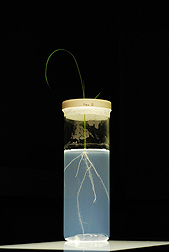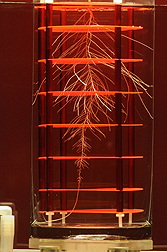New Tools for Studying the Root of the Matter
|
|
Like any structure, a root has its own architecture. Some roots burrow straight down into the soil. Others scatter weblike tentacles. However they turn out, root systems play a critical role in the health and survival of today’s crops. That’s why Agricultural Research Service scientists in Ithaca, New York, have developed a new tool for studying root architecture, one that brings them out in three-dimensional color. It’s a major step forward in a challenging field.
Studying root-system architecture can be extremely difficult because the opaque nature of soils makes it hard to capture and visualize the root structures. Also, field conditions, such as soil chemistry and soil moisture, can vary from one site to the next, and changing conditions dramatically affect the shape, size, and health of a root system. But root structure, health, and formation have become important traits of interest in recent years as scientists search for varieties of crops with roots that equip them to adapt to drier habitats and changing climates.
Scientists have grown plants hydroponically in pots and on plates and have used tools ranging from magnetic resonance imaging to computer-assisted tomography to study root architecture. The latest technology includes transparent gels that allow them to observe roots at different stages of development as the root and plant grow together in a kind of suspended animation. With computers and digital photography, researchers have even developed two- and three-dimensional imaging systems to record roots as they develop in the transparent gels.
Leon V. Kochian, director of the ARS Robert W. Holley Center for Agriculture and Health in Ithaca, and Randy Clark, a Cornell University doctoral student working with him, have developed a three-dimensional imaging system and software package that allows scientists to collect data on root systems faster than ever before and study root architecture in unprecedented detail. Called “RootReader3D,” the system gives scientists the ability to analyze root structures and growth patterns, compare one root system with another, and genetically map and explore traits that give plant roots the capacity to reach into the soil and collect water, phosphorus, and other nutrients, Kochian says.
Testing the System on Rice
To test their system, the researchers grew two varieties of rice in transparent gels and tracked root growth by imaging the plants and their roots for 10 days. “We put the plants on a computer-controlled rotational stage and took digital images of the root system at every 9 degrees of rotation, so there were 40 images of each plant. The entire imaging process takes about 5 minutes per plant,” Kochian says.
They chose rice for the analysis because rice root systems are extremely complex, and the way rice adapts to environmental changes can vary widely from one type of rice to the next. Cultivated rice ranges from highly managed, irrigated systems to types grown in unmanaged fields. The researchers intentionally selected two very different types of rice, Azucena and IR64, for analysis. IR64 is a lowland rice grown in flooded rice paddies, while Azucena is an upland rice adapted to nonirrigated fields.
In more recent experiments, the researchers have imaged the entire root systems of 400 different rice lines in a rice-diversity panel; this has involved phenotyping the root systems of 2,000 rice plants and then developing three-dimensional images of each root system. They scored the root systems for 27 traits that describe both the individual root types, such as the primary root, crown roots, and lateral roots, as well as the architecture of the whole root system. They noted when each root component first appeared and tracked its growth. The ability to isolate and track such root components will help scientists make comparisons among crops and characterize the developmental and genetic differences in root systems, with the ultimate goal of identifying genes underlying control of root system architecture, Kochian says.
Scientists elsewhere had previously taken two- and three-dimensional images of root systems of plants grown in gels. But those systems required up to an hour to collect enough data for a single three-dimensional image. The RootReader3D system offers more detailed results and is much faster. With it, scientists can image more than 100 root systems a day, providing the information needed to conduct genetic-mapping experiments of root traits.
The researchers found that the RootReader3D system was able to delineate, in greater detail than ever before, significant differences between two rice root systems. The results showed that Azucena rice had deeper roots than its irrigated cousin IR64 and that the two root systems were significantly different in terms of their “bushiness,” how their root volume was distributed, and the vertical position of the center mass of the root system.
Results were published in and featured on the cover of the June 2011 issue of Plant Physiology, with Clark as lead author and Kochian as senior author. The work is part of a long-term collaboration between Kochian’s research unit and Susan McCouch, a professor of plant breeding at Cornell. The research was partially funded by the National Science Foundation. The RootReader3D software is available at www.plantmineralnutrition.net/rootreader.htm.
The researchers hope to use the data they collect using RootReader3D in future studies that identify genes controlling important root developmental traits. The ultimate goal is to be able to help plant breeders develop varieties of rice—and other crops—with roots that make them better equipped to handle drought, heat, poor soil quality, and other stresses in a changing world.
“It will be an enormous help, not only in comparing different root systems, but also in exploring the molecular basis of root formation and root architecture to gain an understanding of the genetic mechanisms that give plants the ability to form the kind of roots they need to survive and thrive,” Kochian says.—By Dennis O'Brien, Agricultural Research Service Information Staff.
This research is part of Plant Genetic Resources, Genomics, and Genetic Improvement, an ARS national program (#301) described at www.nps.ars.usda.gov.
Leon V. Kochian is with the Robert W. Holley Center for Agriculture and Health, Cornell University, Tower Road, Room 121, Ithaca, NY 14853-2901; (607) 255-2454.
"New Tools for Studying the Root of the Matter" was published in the February 2013 issue of Agricultural Research magazine.








